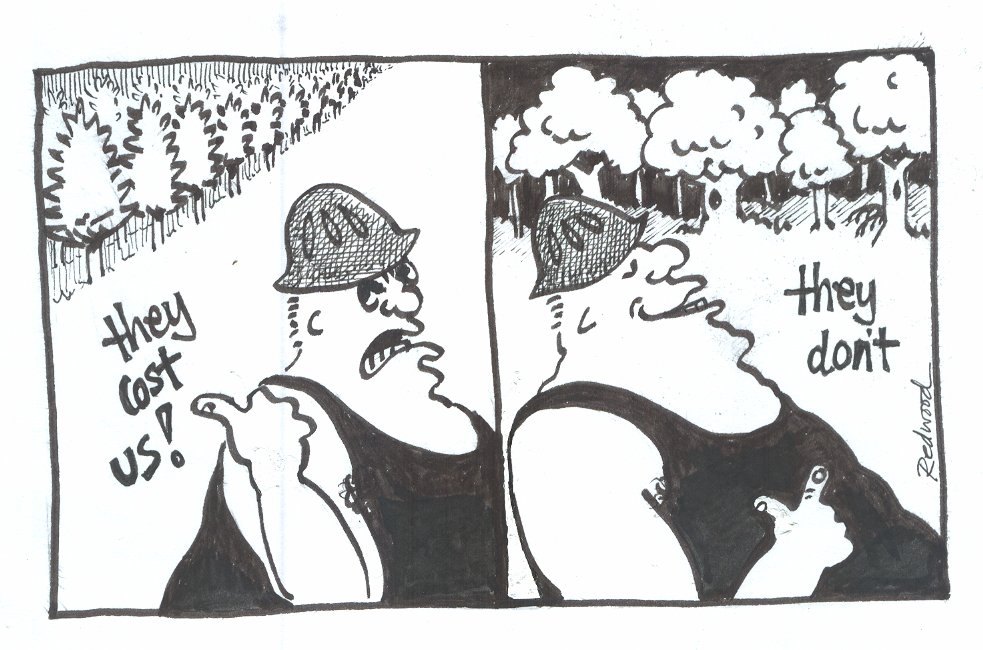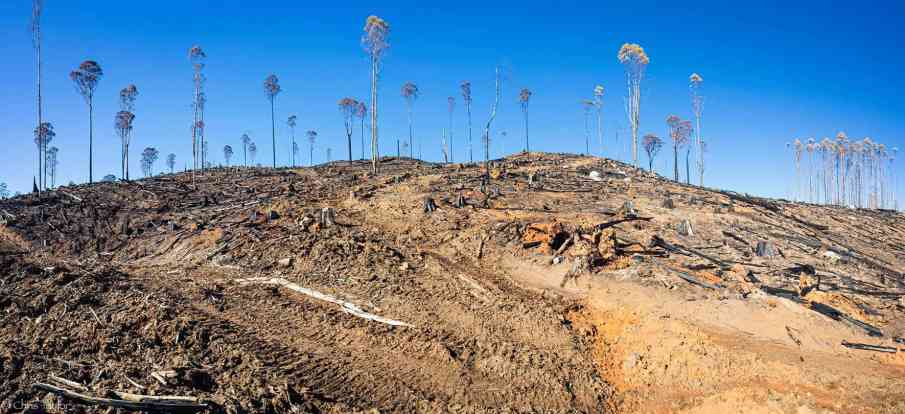A DEAD LO$$
Logging Off!
A cost-benefit analysis of land use options for the native forests.
Blueprint Institute 15/11/22
This report ‘Logging off! A cost-benefit analysis of land use options for the native forests of the Central Highlands, Victoria’, argues why governments must move away from the exploitation and expedience that has dominated land use decision to date. Even in economic terms alone, it shows logging native forests is insanity. A summary was published by the Financial Review 15th Nov 2022 (scroll below).
The native forest industry has been on a course of structural decline since the early 1990’s.

Due to a combination of declining demand, diminishing timber supply and increasing global competition. Despite massive Government grants to provide life support to the industry, log production from native forests has declined precipitously, falling by 44% between 2005 and 2019.
Compounding this loss has been the decline in the global demand for woodchips since 2008, which fell from 33% during the period 2008-2012

In Victoria, 19 out of 20 jobs in the forestry sector are based on plantations, and in 2016 there were only 506 full-time equivalent jobs directly employed in the native forest industry.
The Victorian Parliamentary Budget Office has shown that the Victorian economy would be $192 million better off if the native forest logging industry was closed immediately.

The difference between plantation and native forest logging
Currently, plantations produce over 85% of the logs harvested annually across the continent.
Plantation timber is out-competing native timber. They require less land area for greater log volume.
Plantation softwood timber generates 60% less greenhouse gas emissions than hardwood native timber.

Plantation forestry also offers an abundance of secure, sustainable employment opportunities for regions. They maintaining timber production while preserving our diverse native forests.
The predominant specie of tree (over 65%) that is logged here in Victoria is the endangered mountain ash. VicForests have been allocated 60,000 hectares of mountain ash forest, despite the fact that they that are the second-tallest trees on earth, the tallest flowering plants that are some of earth’s most carbon dense, with up to 1,800 tonnes of above- ground biomass per hectare
Mountain Ash forests are crucial for biodiversity conservation and endangered wildlife like the Leadbeater’s Possum. These forests generate most of the water for the more than five million people in Melbourne, along with many other communities.
As it stands today here in Victoria, the equivalent of over four Melbourne Cricket Ground’s worth of native forest is being logged in Victoria every day.
In the 2020/21 period VicForests made a net loss of $4.7m that compounded on a $7.5m loss the previous year.

VicForests financial future is a bleak one. As a result of a number of factors -notably diminishing supply and recent Supreme Court rulings, it will be forced to log marginal forests that require progressively higher logging and haulage costs.
VicForests’ have survived only by relying on generous state government grants every year, courtesy of the Victorian taxpayer. These grants are not publicly disclosed or accounted for in annual statements.
Logging and fire severity
Logging of native forests make forests drier, and therefore more prone to fire.
Studies following the 2019-2020 Black Saturday bushfires confirm that there was a 25% increase in fire severity in logged forests compared to forests that remained unlogged. Logging regrowth, increases fire severity.
The Victorian government announcement (February 2020) of proposed changes to logging rules, would weaken protections for bushfire-prone communities and the environment.

Although the Victorian Government has flagged the (political never-never) date of phasing out of native forest logging by 2030, (conveniently pitched on the year The Forests Wood Pulp Agreement expires), this decision has not been legislated. Another 8 years of logging would wipe out the remainder of high quality forests.
Carbon
The mountain ash forests of the Central Highlands contain the highest density of carbon globally—storing approximately 1,867 tonnes of carbon per hectare: two to five times higher than that of previous estimates.
Based on the Australian carbon credit unit spot price of $29.75 per tonne (Oct.2022), and a seven percent discount rate, these 2.64MtC have a net present value of $63 million.
Maintaining a forest to act as a carbon sink, has a great economic value to the State. Continuing to log within native forests, would reduce carbon stocks more than wildfires.
Tourism
Being geographically close to Melbourne’s spiralling population, the Central Highlands Region, Blueprints analysis estimates that increased tourism to the region could provide a value of $34.2 million across the eight years.

Within Victoria (2018-2019), the most popular recreational activity by tourists included outdoor and nature-based activities. Overall in this period, 64 per cent of visitors to Victoria participated in nature-based activities.
When tourist come, employment opportunities increase exponentially.
Water
The native forests of Central Highlands Region of Victoria are the origins and filters of our water supply and their catchments, the lifeboats of some of the purest drinking water in the world. They feed five reservoirs – Maroondah, O’Shannassy, Upper Yarra, Thomson, and Tarago, totalling 1,331GL. These reservoirs supply water for Melbourne’s population of five million people.
Logging has been clearly shown to reduce water yield from forested areas by up to 50%, thirty years after logging and is projected to take 150 years to return to pre-logged levels.

This water loss occurs because mature forests use very little water, allowing rainfall to be filtered and slowly flow into streams and catchments. In contrast young fast-growing trees take up large amounts of water.
The SEEA based study shows the economic value of the water in all of Melbourne’s catchments is more than 25 times the economic value of the timber, woodchips and pulp produced from all Victoria’s native forests.
The Financial Review Story below
Immediately ending native forest logging across Victoria’s central highlands, one of the world’s most intense carbon sinks, would generate an extra $60 million in benefits for the state this decade alone.
In a challenge to the Andrew government’s ongoing support for logging of native wet forests – a position that Greens are actively campaigning against in the state election – a report by the right-leaning Blueprint Institute to be released on 15/11/22 finds preserving trees generates more in tourism, water supply benefits, and carbon credits than cutting them down.
“We’re not opposed to the logging industry in and of itself, particularly plantation logging, but we are saying it’s not great to chop down wetland at the best of times,” said David Cross, the Blueprint chief executive. “And given there’s no economic benefit in doing so there’s even less justification.”
The native forest logging issue is a critical point of difference between state Labor and the Greens, who are gunning for three inner-city Melbourne seats that could put them in the running to be kingmakers in a hung parliament.
The Labor government has said it is spending $200 million to keep the industry alive until 2030, but Mr Cross says subsidies, which were not counted in Blueprint’s figures, were really about protecting 500 to 600 jobs, “which are overwhelmingly CFMEU members”.
Victoria’s ongoing support for native logging comes as federal Labor committed Australia at this month’s climate summit in Egypt to a global ban on deforestation.
In an attempt to climb above ideological differences over logging, Mr Cross said Blueprint’s primary goal was to take a “black letter economics approach to determine whether it makes sense or does not make sense”.

“The thing that has really baffled us from analysing the central highlands as a case study is that for a long period of time it’s been a completely loss-making, government subsidised industry that can’t compete against plantation forests.”
Blueprint estimates that halting native wet forest logging in one of the world’s most “biodiverse environments” would generate $487 million in benefits, offset by $428 million in costs to create a net present value of $59 million between 2022/23 and 2030.
Included in the benefits are $365 million from avoided logging work, $63 million from carbon sequestration credits, and $59 million from tourism.
Costs include $25 million to develop tourism alternatives and $403 million in lost revenue from native forest logging.
“The native logging industry is propped up by government to protect an ever-decreasing number of jobs and placate misguided pressure from vested interests,” the report’s authors state.
“Economic protectionism is damaging and regressive at the best of times. This is amplified exponentially when it results in severe environmental degradation.
“Our native wet forests are at high risk of collapse unless the right policy settings are put in place to protect them into the future.
”It is critical that policymakers take a more expansive view when assessing land value – that they move away from the ‘what’s in it, what’s on it, how do we sell it’ paradigm that has dominated land valuation methodologies to date,” Blueprint states.
Compared to plantations, native forests are both hugely inefficient and effectively crowd out businesses that grow trees for construction and furniture timber.
“There’s nothing you couldn’t make up by importing from plantation forests elsewhere. It’s protectionism writ large,” Mr Cross said.
“The existing plantations in Victoria have the capacity to provide more should they want to, but currently it’s just not economically a smart decision for them to do that when they’re getting crowded out by Vic Forests.”
Ongoing logging of native forests across Victoria’s central highlands, a key water catchment for Melbourne, would result in the release of 2.6 million tonnes of carbon. Based on today’s dollars, and a carbon price of $29.75, that generates a net present value of $63 million for the carbon stock.
“Ending the logging of the wet forests prevents the release of ancient carbon back into the atmosphere, and allows them to grow – maintaining a vital source of carbon storage and carbon sequestration,” the report’s authors write.
Blueprint said its modelling could be applied to any native forest area in Australia.
Thanks to Rod Falconer for the original summary of the Blue Print report first covered by this Financial Review. Rod was a founder of the Rubicon Snobs Creek Reserve.
